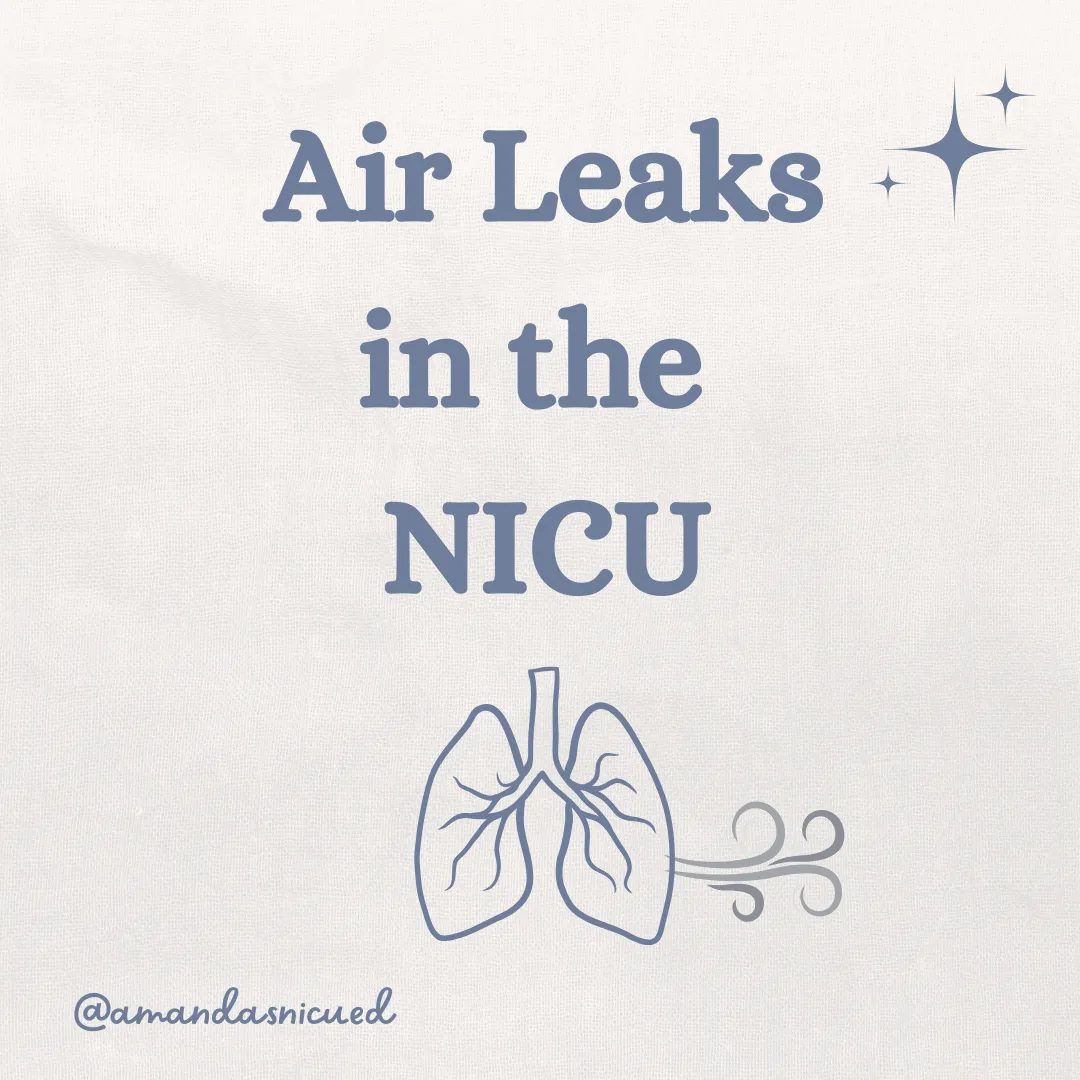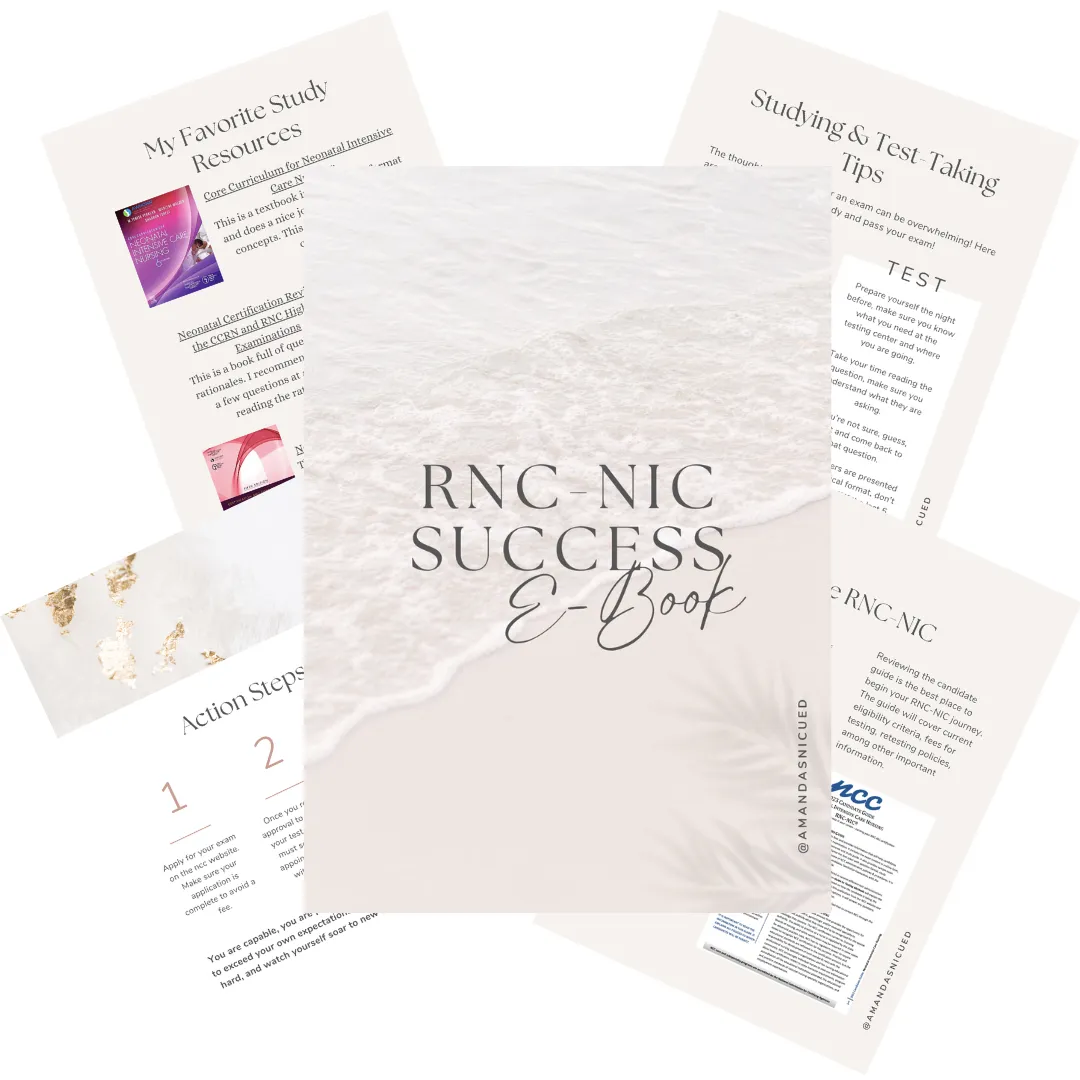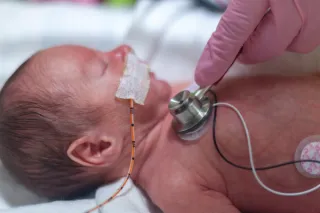
Welcome to Amanda's NICU Education




Hi! My name is Amanda. I'm a NICU nurse, Clinical Nurse Specialist, NICU Educator... basically your NICU BFF. If you want to talk NICU, I'm here for you! I love everything about NICU nursing and I'm eager to learn and share my knowledge with all my NICU friends.
I have been a NICU nurse since 2009 I am currently a Clinical Nurse Specialist in a Level IV NICU in Los Angeles.
I am passionate about educating the next generation of NICU nurses. I share my knowledge through platforms such as Instagram and Facebook and am excited to have you here on my website!
Click on the button below to sign up for my newsletter filled with NICU education and tips for all experience levels.

Not very many people love taking tests but as a self-acclaimed "forever student" who has taken (and passed) five different certification exams I am no longer afraid of tests! "Way to brag", you might be thinking but I want to help YOU pass your certification exam too!
Introducing Amanda's RNC-NIC Success digital course - your ultimate study companion!
Gain unlimited, on-demand access for life, ensuring you're primed to ace your certification exam.
I'm here to help you succeed and I can't wait for you to share with me that you PASSED the RNC-NIC EXAM!!!










Air Leaks in the NICU
Air leaks are among the most concerning and scary complications we face in the NICU—requiring both keen observation and swift response. Let’s explore the types of air leaks, why our tiniest patients are at risk, what nurses can do in moments of crisis, and why our role truly matters. 💙
What Types of Air Leaks Are Seen in the NICU? 🩺
NICU infants may experience several kinds of air leaks:
Pneumothorax: Air enters the pleural space and compresses the lung, making breathing difficult.
Pneumomediastinum: Air collects in the mediastinum, often showing a “spinnaker sail” sign on chest X‑ray.
Pulmonary interstitial emphysema (PIE): Air escapes into lung tissue, disrupting gas exchange.
Pneumopericardium: Rare but serious—air around the heart can affect cardiac output. 😟
Here is an X-Ray of a tension pneumothorax. Notice how the heart is being shifted to the babies left side. What signs do you think you would see in this baby?

Pediatric Imaging, 2020
Why Are Neonates Particularly Vulnerable? 🍼
Our patients are especially at risk because:
Their lung tissue—particularly in preterm infants—is fragile.
The thin pleural membranes are easily disrupted.
Tools like CPAP or ventilators, while lifesaving, increase pressure in delicate lungs predisposing their risk of injury.
Conditions like Respiratory Distress Syndrome result in uneven lung compliance, creating areas of overdistention.
Signs of an Air Leak 🚨
Early recognition of air leaks can make all the difference. Watch for these red flags:
Sudden respiratory distress: Rapid breathing, grunting, flaring, or increased oxygen needs.
Asymmetrical chest movement: One side not expanding fully—especially with pneumothorax.
Heart rate/blood pressure changes: Bradycardia, tachycardia, or poor perfusion.
Diminished breath sounds: Reduced or absent on one side during auscultation.
Soft‑tissue swelling: Facial, neck, or chest swelling may suggest subcutaneous emphysema.
Transillumination: A quick bedside tool we may use for IV starts can also be helpful to identify a pneumothorax!
Staying alert to these signs is key to early intervention and better outcomes.
Notice in the image below how the whole chest is glowing when the transilluminator is placed against the chest. This can be a great tool when you suspect there may be a pneumothorax.

Gupta, A & Dirnberger, D, 2020
The Most Common Air Leak: Pneumothorax 🌟
Pneumothorax stands out as the most frequent air leak in the NICU, often affecting very low–birth-weight infants on respiratory support. Sign of a pneumothorax include respiratory distress, tachycardia, tachypnea, a shift in the point of maximal impulse, or a increased oxygen requirement. Fast recognition is essential.
How Can NICU Nurses Be Prepared? 🛡️
Through careful preparation and teamwork we make a lifesaving difference:
Vigilant monitoring: I remember monitoring a little boy on CPAP, whose was unusually restless, and was have frequent desaturation. oxygen saturation dropped unexpectedly. I noticed his chest was moving in an abnormal asymmetric pattern—indicating a possible pneumothorax.
Swift communication and escalation: I alerted the team, who immediately ordered a stat chest X‑ray and supplies for a thoracentesis.
Procedural support: I helped set up the supplies and supported the neonatologist who performed the needle thoracentesis.
Post‑procedure care: After the thoracentesis, I closely monitored the baby and he was breathing much easier.
Family education and support: The baby's parents were understandably frightened. I explained what was happening and checked in frequently to update and reassure them. When I finally saw their relief, I knew my presence mattered. 🥰
🌟 Elevate Your Expertise: Join The Air Leak & Chest Tube Webinar
If you're a NICU nurse or clinician, I invite you to join my webinar “Air Leaks and Chest Tubes in the NICU” on Saturday, June 28. We’ll dive deeper into recognizing air leaks, best practices for chest tube care, and ways to provide families with both competence and compassion. Register now to empower your practice—and save more little lives. 🙌

If you liked this blog, check out my blog on Chest Tubes by Clicking Here
Missed my other newsletters? Click here to read them!
References:
Pediatric Imaging. (2020). Premature newborn with respiratory distress on a ventilator. Retrieved from https://pediatricimaging.org/2020/11/19/premature-newborn-with-respiratory-distress-on-a-ventilator-9/ on June 15, 2025
Beaton, A., Sendi, P., Martinez, P. A., & Totapally, B. R. (2024). Prevalence and outcomes of air leak syndrome and subtypes in neonates in the United States. Journal of neonatal-perinatal medicine, 17(6), 846–857. https://doi-org.mlprox.csmc.edu/10.1177/19345798241308491
Jhaveri, V., Vali, P., Giusto, E., Singh, Y., & Lakshminrusimha, S. (2024). Pneumothorax in a term newborn. Journal of perinatology : official journal of the California Perinatal Association, 44(4), 465–471. https://doi-org.mlprox.csmc.edu/10.1038/s41372-024-01899-2
Cagle K. J. (2014). Pneumomediastinum in the neonate. Neonatal network : NN, 33(5), 275–282. https://doi-org.mlprox.csmc.edu/10.1891/0730-0832.33.5.275
Gupta, A., & Dirnberger, D. (2020). Thoracostomy. In MacDonald’s Atlas of Procedures in Neonatology Sixth Edition. LIPPINCOTT WILLIAMS & WILKINS.


December 2023 Certification Review Webinar
NICU Certification Review



Ready to kickstart your journey to becoming a certified NICU nurse?
Look no further!
Grab my FREE E-Book packed with essential study and test-taking strategies for the RNC-NIC.
In the E-Book I give you the resources you need including the link to access the candidate guide, several types of books to study from, some of my favorite strategies, an outline of the content you should review, and a blank calendar for you to make your study plan!
Frequently Asked Questions About the RNC-NIC exam

What is the RNC-NIC?
The RNC-NIC is a competency-based exam that tests the specialty knowledge of nurses in the United States & Canada who care for critically ill newborns and their families.
The RNC-NICU is a nationally recognized certification that recognizes the registered nurse for their specialty knowledge and skill.

Who can take the RNC-NIC exam?
Nurses can take this exam after a minimum of two years experience in the NICU caring for critically ill newborns and their families.

Which books should I use?
I'm glad you asked! There are many excellent books to help you prepare for the RNC-NIC, I gathered ande describe each of them for you in my FREE e-book.
Is there a course to help me study?
Yes! Many hospitals host their own certification course and there are a few online courses. See my RNC-NIC test taking tips E Book for more information
What happens if I don't pass the exam?
If you don't pass the exam on your first try you can try again after 90 days. You will have to reapply after 90 days and pay a retest fee. There is no limit to the number of times you can take the exam (however a candidate can only sit for the exam twice per year).

Can I make more money if I take the RNC-NIC exam and get certified?
Yes! Many hospitals provide a raise or a bonus for nurses with specialty certifications. Hospitals also typically hire at a higher base salary when nurses have a certification.

Find me @amandasnicued on these channels or Email me
hey nurses don't miss out
© Copyright 2024. AmandasNICUEd. All rights reserved. | Terms & Conditions | Privacy Policy Contact: [email protected]

